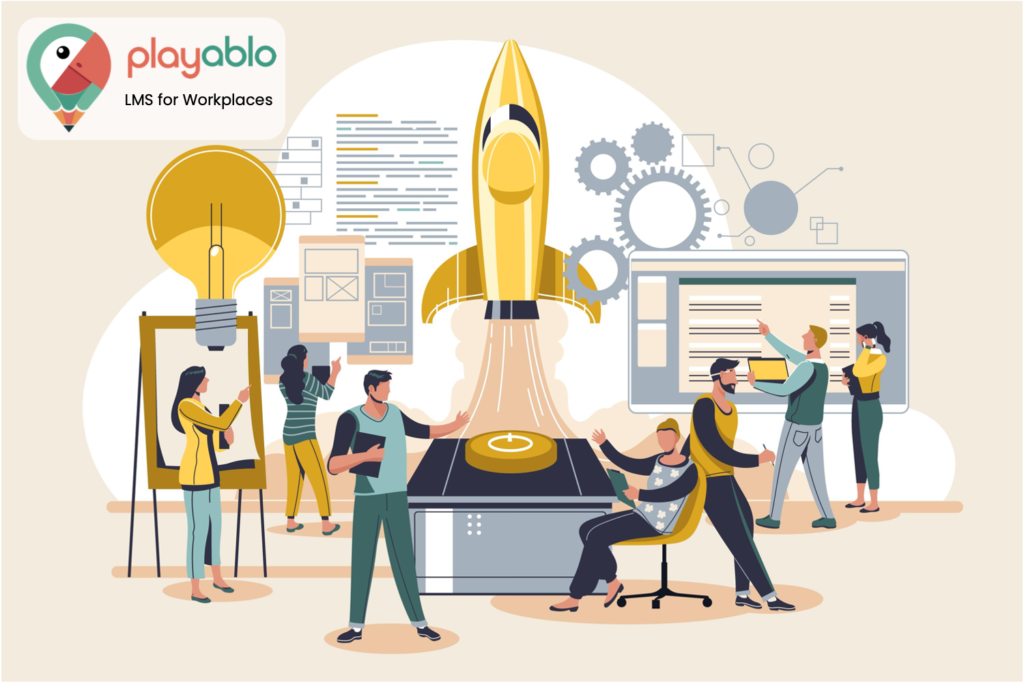The future of workplace learning is already here, and it’s not just about new content or cutting-edge digital platforms. Employees have transformed how they learn on the job, with many seeking solutions on their own rather than relying on learning and development departments. That isn’t to say that the L&D department is no longer relevant. It does, however, imply that it will most likely need to change in regards to its roles and responsibilities.

But how do you do it? L&D is becoming increasingly digital for every learning leader. As a result, practically anyone can now learn almost whatever they need, whenever they choose, on their own. What isn’t evident is how learning and development teams should adjust to this new reality. To address such a question, we must first comprehend how today’s workers develop their talents. These individuals operate at all levels of organizations, in large and small businesses, in various industries and job types.
So, today, let’s address this critical question: What Are the Evolving Roles and Responsibilities of L&D Leaders in the Future of Workplace Learning?
Table of Contents
Evolving Roles and Responsibilities of L&D Leaders in the Future of Workplace Learning
People’s investment in an on-demand economy
Most CEOs do not invest in people out of altruism or social conscience. Management invests in the future of workplace learning to increase productivity and performance. Chief executives get compensated primarily for delivering value to shareholders, which one derives mainly from increased earnings.
Read More: Go To Market and the Role of L&D Leaders!
So what if employees are dissatisfied with their training? Because learning and development are among the most potent tools businesses have to boost productivity, research shows that employee engagement predicts future financial success.
People are a high cost, accounting for a considerable part of the operating costs in many firms. As a result, we talk about human capital management more than we talk about investing in people. In recent years, employers have contributed a significant section of the payroll and into the contingent workforce as a continuous efficiency drive.

Freelancers, contractors, and temp workers are also on the rise. This is a relevant factor to consider in the future of workplace learning. A growing number of firms are using contract and temporary (“gig”) employees.
Employees value the flexibility and independence of contract jobs above the typical structure of a steady 9-to-5 job in the gig economy, which signals a shift in how they view work. Organizations are grappling with how to train these new types of workers, who may not have access to typical employee systems like learning portals, as the gig economy grows.
When it comes to achieving optimal performance for the organization, the L&D roles and responsibilities function must think outside the enterprise. As the nature of work changes, L&D is adapting by providing learning opportunities for employees that go beyond standard corporate training.
Again, when it comes to individuals in the on-demand economy, efficiency takes precedence over engagement.
This push for efficiency has altered L&D roles and responsibilities as well. Corporate training is increasingly given through technology to increase reach, reduce expenses, and improve consistency rather than satisfy the unique demands of Generation X, Millennials, or the Homeland Generation (those born after the mid-1990s).
Read More: 5 Strategies to Design an LMS for Millennials and Gen Z
Investing in efficiency alone, on the other hand, isn’t enough for today’s workers. The desire for efficiency, on the other hand, isn’t going away. As a result, traditional trade tools such as instructional design, facilitation, learning management systems (LMS), e-learning courses, virtual classes, and fast authoring tools are still helpful. They’re simply unfinished. In addition to efficiency, tools must handle engagement in the future of workplace learning.
L&D: for the people and by the people

Because we don’t merely gain knowledge through formal training, workers require more than traditional training solutions. Every day, we grow as a result of our informal experiences and relationships with others. You’ll need it all to boost productivity and performance. There are official and casual occasions: Self-serve and L&D. Efficiency and participation.
The word “and” is crucial here. Formal training is still an essential element of how workers learn new skills and keep their existing ones sharp. At least once a year, employees prepare virtual or e-learning courses at work. However, this still only happens once or twice a year.
Workers rely on social and on-demand learning in the interim. People learn for work by looking things up online or from their colleagues, reading articles or blogs, and watching videos. Learning and development roles and responsibilities are no longer just the obligation of the L&D department. Everyone’s employment is interwoven with them.
Read More: What is Social Learning, and How Workplaces Can Benefit from it?
People do learn on their own, independent of their employers’ teaching. Nonetheless, they require – and desire – guidance. Workers who are given proper advice are much happier with their companies’ training and development chances than those who are not.
These days, though, their supervisors, peers, and technology are more likely to provide help than their leaders. When they need to learn something new for work, few people go to their L&D departments or search their LMS first. Others, however, consult their employer or mentor, while the rest seek advice from colleagues or hunt for solutions or resources online.
For CLOs and their staff, this is an opportunity, not a danger. To execute their professions, people still require operational knowledge and skills training. However, today’s workers must learn and improve daily, not simply on occasion. As a result, the L&D function’s roles and responsibilities in developing and delivering programs, seminars, and courses is expanding, not contracting.
Visionary leaders now enable learning rather than merely supplying it. They create different ecosystems and cultures that allow everyone to have on-demand access to the most significant learning resources, relate development to career and organizational goals, and interact with one another for guidance, coaching, and collaboration.
Workers and management: working for a perfect union of L&D

Sharing control with workers and managers is easier said than done for most CLOs. Training mindsets are frequently entrenched, budgets are often slashed, and methods are frequently established. As a result, an increasing number of learning teams are embracing their new position by adopting new ways of thinking, investing, and working.
Prioritizing workers’ demands alongside the company’s results in a diversified portfolio that caters to various groups with tailored solutions. Live workshops and online classes are still part of the offer. Short-term tasks, massive open online courses, mobile performance help, digital communities, and on-demand services are all included.
That diversity can sometimes come at the expense of efficiency and management. The talent development team as a whole is always looking for new tools and approaches to use. They employ people from outside of education to try out new ideas and talents. They also collaborate with employees to curate learning opportunities.
Read More: Top 20 LMS Features Checklist for the First-time LMS Buyer
Here is how the near future of workplace learning appears. L&D teams with roles and responsibilities that are more advanced already give less training in classrooms and through LMSs than those less advanced. They also offer additional on-the-job training, coaching and collaboration, and on-demand resources such as videos, articles, and books.
Ad: PlayAblo’s Enterprise-Grade Micro-Learning platform is built for the corporate learner. Micro-Learning, along with assessments and gamification features, ensures learning outcome measurement along with sustained engagement.
Find out more and request a custom demo!
These next-generation L&D teams aren’t undertaking this transition in their roles and responsibilities out of altruism or social conscience. They’re doing it because it helps them be more efficient in developing people’s skills and driving business results. They are also more cost-effective as a result of this.
The importance of soft skills training
Automation and artificial intelligence (AI) are changing business processes, and the future of employment will involve jobs that don’t exist today. The fast repurposing of talent that we saw in 2020 isn’t going to stop anytime soon. Indeed, the World Economic Forum’s 2020 Future of Jobs report shows how automation, another major disruptor of roles and responsibilities, will create massive change over the next five years, creating 97 million new jobs while displacing 85 million. Over the next half-decade, there will be a lot of change.
Despite this transition, soft talents such as creativity, flexible thinking, communication, and cooperation will continue to be in high demand. The deficits in soft skills persist across all jobs and virtually all functions, and that firms across all industries are responding by providing several training options. We may infer that this gap exists worldwide, and soft skills training, like data literacy, is becoming increasingly important for corporate and employee success.
A one-and-done training event does not teach soft skills. Employees must participate in various training situations over a long period to develop these skills. Soft skills training will continue to be emphasized. As part of their roles and responsibilities, L&D professionals will need to offer holistic learning experiences to help employees build this vital skill set.
Literacy in Data

There is no shortage of data in today’s business climate, thanks to technology’s reporting and analytics capabilities. Organizations are trying to comprehend how to effectively and ethically use all of this data, especially learning data. Companies that invest proactively in growing their employees’ data literacy beat those that don’t, on various criteria, including revenue growth, profitability, and employee happiness.
Organizations in any industry cannot afford to overlook this competitive edge, and closing the data skills gap is vital. Organizational performance analysis, performance measurement, and business and training performance assessment are among the weakest competencies for
According to our current competency and career research, L&D professionals now have increased roles and responsibilities. To demonstrate the value of learning to business executives, L&D professionals must take the first step and invest the time and resources to become data-literate themselves. Then we’ll be able to promote the development of this crucial ability throughout the organization.
Investing in learning experience platforms
We’ve seen increasing investment in learning experience platforms due to an injection of finance and consolidation (LXPs). Organizations that need to collect knowledge from different sources and providers to develop more services for employees can no longer rely on traditional learning libraries.
As a result, organizations are shifting to on-demand learning to help employees when they need it. AI and machine learning are becoming more prevalent in various tools, ranging from delivery platforms (LXPs and traditional learning management systems) to chatbot-based coaching tools and content curation apps.
Read More: What is a Learning Experience Platform (LXP)?
In the coming year, we expect more investment to flow into the learning space, emphasizing improving the employee learning experience. As we integrate these developing tools into our companies’ technological stacks, L&D professionals will be thinking about the implications of these technologies, their possible built-in bias, and the source and use of learner data.
Promoting an organizational learning culture

For many businesses, improving and refining the employee experience remains a top priority. A robust learning culture may help employees reach their full potential while also encouraging creativity and innovation. The benefits of a great learning culture may even attract exceptional personnel and help them remain longer at a company.
The task at hand is to define L&D’s role in fostering that learning culture. The C-suite, human resources, organizational development, and learning and development teams all have a stake in building and maintaining the company’s learning culture. They all have duties in doing so. The tone at the top matters, and our research reveals that leaders believe they are investing enough to maximize the company’s learning impact. The difficulty for L&D is to ensure that the investment is yielding the expected results.
Read More: Building a Culture of Learning!
Customer education’s pervasiveness
Users adapt to changing technology, whether by downloading a new app on their phone or installing new software on their work computer. No formal training is required today because every gadget has some self-help capability. To answer frequently asked questions, several tools include short videos or essays. There’s also an increasing emphasis on creating technologies with an intuitive user experience that allows for self-navigation.
As a result of these changes, it’s possible to say that customer education has mainly evolved into a self-help model, with customers upskilling as needed. Because technology is changing so quickly, these training tools must be current and straightforward. Because they must be agile, they may be of poorer quality than more traditional training resources.
L&D needs to reconsider the value we can add to the growth of this critical form of extended enterprise learning. These programs’ instructional design will save money and reduce risk, but do we have a seat at the table? Best-in-class firms recognize the role of learning and development in effective customer education programs.
Remote learning

“I think in 10 years’ time [Augmented Reality] may be commonplace. Whether it’s a virtual coach that is there looking and seeing what you are doing and guiding you through it or in some of the more manufacturing or technical aspects, or whether it is just in time performance support that is guiding you through looking at what you are seeing and overlaying what you need to be doing.” Simon Brown.
Finally, we must consider how our learning and working environments are changing. Remote work is here to stay — at least in some form – and our learning methods must adapt. Over the next decade, virtual and augmented reality’s promise to promote continuous learning will be realized.
It’s not a good idea to deploy new technology just for the sake of it. Once again, we must concentrate on the business requirement and the resulting business value. While there is a lot of commotion around reskilling, upskilling, and lifetime learning, the impact of fully integrating learning into the very fabric of work and ensuring that it is tightly connected with the business’s goals would be huge. Over the next decade, learning can alter employment, performance standards, and leadership duties.
Conclusion
Rebuilding Learning and Development (L&D) for the digital age and democracy
Getting and keeping employees involved in their work is more important than ever, and L&D is critical to accomplishing this. However, the methods by which we train and develop workers must change.
Leaders in learning and development recognize the need to change. They’re rethinking their learning practices to engage today’s workforce better. Many are investing in new technology or more modern content. Fewer, on the other hand, are reorganizing, reskilling, and recruiting for new talents within their own teams.
The truth is that entertaining, bite-sized content and gamified social learning systems won’t suffice to prepare you for the near future of learning and development. To better balance corporate and individual imperatives, you must also embrace new methods of thinking and doing.
Ad: PlayAblo’s Enterprise-Grade Micro-Learning platform is built for the corporate learner. Micro-Learning, along with assessments and gamification features, ensures learning outcome measurement along with sustained engagement.
Find out more and request a custom demo!







Comments are closed, but trackbacks and pingbacks are open.